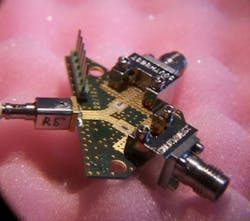Ultrahigh-speed VCSEL reaches 40 Gbit/s
VI Systems (Berlin, Germany) was awarded US patent number 20130092896 for its "Optoelectronic Device with a Wide Bandgap and Method of Making Same." The vertical-cavity surface-emitting laser (VCSEL) technology enables data-transmission speeds of 40 Gbit/s for 850 nm lasers operating at temperatures up to 80ºC and 25 Gbit/s speeds at elevated 100ºC temperatures. The patent is applicable to both visible and infrared VCSEL devices, and can also be applied to light-emitting diodes (LEDs) targeting the bright red, orange, yellow, and even green spectral ranges.
VCSEL technology has previously been transmission-speed-limited because of leakage of the injected nonequilibrium carriers from the gain medium into the passive cladding areas due to the thermal tail of their energy distribution. This leakage degrades device performance at elevated temperatures and at high current densities—particularly important for high-speed operation. Furthermore, the leaked carriers can recombine at point defects near the oxide aperture of the devices and result in fast degradation of the device. By applying a proper barrier structure with a specific composition, VI Systems has succeeded in increasing the barrier heights for nonequilibrium carriers and enabling ultra-high-speed VCSEL operation at high temperatures. Sample bare chips and fiber-coupled modules are available now. Contact George Schaefer at [email protected].
